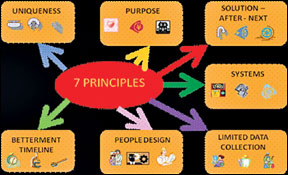|
Breakthrough thinking:
Learn and create your future
Eng. Gamini Nanda Gunawardana
We take in children to schools as (question marks) and release them
to the society as (Full stops). This is what present day conventional
education system does. One of the greatest philosophers of our time
Henry David Thoreau; said “Our education system makes a straight cut
ditch of a free meandering brook.”
|

Albert Einstein once said - “Problems cannot be solved by
the same level of thinking that created them” |
Through the conventional education system, we all have been trained
to look at our past performance, history records and to extrapolate to
the future in order to predict our sales projections, to forecast
weather patterns and even to predict countries development indices.
The world is changing fast. New technologies are emerging; cultures
are going through drastic changes; natural disasters are becoming more
and more unpredictable - which all of us experienced during past few
days; world hegemony is being shifted to Asia. With all these rapid
changes around the world validity of using past to predict future with a
certain degree of certainty is becoming more and more questionable. If
future is not a reflection of past predicting future based on past
performance is similar to driving a motorcar forward by looking through
the rear mirror. We all know what would be the outcome.
Be optimistic
Albert Einstein once said - “Problems cannot be solved by the same
level of thinking that created them.” If so, what is the solution? What
is the higher level of thinking that can be used to solve today’s
problems?
|

Figure III - Breakthrough Thinking seven principles |
By now most of you are feeling uncomfortable, confused and may be
even depressed. Nothing, wrong with you. When you feel uncomfortable
doing something it’s because you are pushing your limits. What comes
after that is excellence. Be optimistic. What has gone wrong is the
education system we have been trained to think over four centuries. Our
education system is based on rational and logical thinking process
developed by Rene Descartes in 1596 - 1650 AC. This, predominantly left
brain activated rational and logical thinking process undermines the
innovation and creativity the right brain can infuse in problem solving.
The Descartes Thinking Paradigm is based on machine theory and
fact-centrism. Descartes believed that;
* Everything is divided into elements
* The elements can be replaced
* The partial can solve the whole and
* The sum of parts is the whole
Analytical approach
Although above assumptions are true for a machine world; are those
assumptions hold good in an Organic World. Certainly still human beings
are not robots. Hence the progress of human beings is hindered by the
limitations on Analytical Thinking Process. Generally using the
analytical approach for finding solutions, we may visit an advanced
country and try to learn from their past and present successful cases
there. This is dangerous. Why?
|

Figure - I Self locking bicycle |
* While we are analyzing and/or studying the present situation, our
competitors will advance more. We may not be able to catch up with them
and always will be a follower.
* We may try to introduce the learning from a foreign country here
totally disregarding the differences such as cultures, people, situation
and objectives in a developing country while reducing the effectiveness
of the solution and losing our creative thinking power.
* With the technological developments taking place in the 21st
Century we are facing drastic changes in every sphere of activities.
Hence projecting future based on past using the conventional problem
solving method may not be effective and accurate.
Ideal future solution
If Sri Lanka is to emerge as a developed nation, it is essential to
get away from conventional analytical thinking process and concentrate
on developing breakthrough products and services.
Approach to facilitate creativity, innovation and to look at things
from a different perspective is called ‘Design Approach’ or paradigm
shift to Breakthrough Thinking. Breakthrough Thinking is based on
“Learning from the ideal future solution and Designing an ideal future
solution”. Breakthrough Thinking can help to bypass the advanced
countries and companies, because this approach does not copy or import
the successful cases and it is a substance-based-thinking. Breakthrough
Thinking is based on the epistemology of system view, which means
organic view, purpose orientation and interdependent holistic view,
completely different from the conventional Descartes Thinking paradigm.
|

Figure - II To school on skateboard |
Defining the purposes or the substance of working on a problem
ensures that you will apply your efforts in areas where you can have the
greatest impact. Thinking about the purposes for working on a problem
prevents wasted effort. This approach guarantees that you are not going
to be working on something that will not meet your needs. Further,
finding the right purpose greatly increases your chances of discovering
a breakthrough or an innovative solution. Finding the right purpose to
work on involves thinking about purposes at different levels. For any
problem there can be many purposes of solution.
Missing bicycle key
Let’s consider a small problem: finding a missing bicycle key.
You buy a new, expensive bicycle. Since you have had the experience
of having a bicycle stolen, you purchase a chain lock for securing the
cycle while it is unattended. But a problem arises because you have not
made a habit of carrying the key with you and sometimes you misplace it.
We will take this as the problem and keep on expanding to bigger
purposes to see what would be the outcome.
Purpose or substance expansion can go on as follows;
* Locate the missing bicycle key - for what
* To have access to the bicycle - for what
*To have transport - for what
* To go to school
So as you can see once we expand the purposes the problem domain
change from locating a missing bicycle key to a feasible method of
transport to school. If the problem is not to lose the bicycle key the
solution could be a self-locking combination key as shown in Figure I. -
A breakthrough product.
Where as a viable alternative among other feasible solutions such as
school bus, car, cycle motorbike etc. could be skateboard, Figure II - A
breakthrough idea. Generally 5 - 8 percent of people are born with
creativity. Another 5 - 8 percent does not have any creativity - they
are robots disguised as human beings. For them left brain has nothing
right - because everything is logic and rationality and Right brain has
nothing left - because it is technically dead no feelings, creativity or
emotions.
The most incorrigible set of accountants, lawyers, engineers,
doctors, bureaucrats, management consultants fall into this category.
Creativity and innovation can be rekindled in the majority of 85 - 90
percent. Break through thinking is the approach.
It based on seven universal principles - Figure III. Principle 1:
Uniqueness The most successful problem solvers do not begin by trying to
find out what has worked for someone else. We can’t clone others’
successes. Copying what others have done doesn’t necessarily produce the
same results for us.
Principle 2: Purpose
Make sure you are working on the right problem. Ask, “What are we
trying to accomplish?” And, “What is the purpose of accomplishing that?”
and “What is the purpose of that?” Focusing on purposes lets the
uniqueness of the situation become clear and helps to strip away
nonessential aspects to avoid working on just the visible problem.
Principle 3: Solution-After-Next
We must look beyond the immediate situation and its solution, to the
solution we would use the next time we had to address it. Work backwards
from an ideal future solution for achieving needed purposes, not forward
from today’s situation or problem. Having a target solution in the
future gives direction to near-term solutions and infuses them with
larger purposes.
Principle 4: Systems
Most of what we have to cope with in problem solving is unseen. The
systems understanding of our solution serves as sonar and radar,
designed to illuminate the seven-eighths (similar to an iceberg) of all
solution ideas and recommendations that otherwise might be overlooked.
Every solution or system is part of a larger system and solving one
problem inevitably leads to another.
Principle 5: Limited information collection
Don’t become an expert about the problem. Become an expert on
solutions. Before taking the time and wasting the effort to collect and
analyze extensive data, determine what purposes would be achieved by
gathering that data. Data is only a representation of the real world.
Principle 6: Involving people or people design
Individuals are the core to a solution’s success. Their concerns and
ideas must be treated as the fabric of excellent problem solving.
Breakthrough Thinking starts and sustains the entire process with this
principle. Changing the thinking process changes the ‘feelings’ of
people.
Principle 7: Betterment Timeline
No matter how effectively you create a new process or system, or
improve the present one it will never be good enough to meet the needs
of various customers in the future. What happens is a kind of invisible,
slowly creeping process rotting.
Processes that once worked extremely well will be required to meet
additional purposes and requirements over time.
New technology will render certain processes obsolete. People and
environments will change.
Seven principles discussed above are universal and that can be
applied to any situation in your life. If Sri Lanka to progress we
should promote and facilitate creativity and innovation. With that
creativity we will be able to fulfill our ambitions and flourish as
human beings.
Think Smarter, not harder.
The writer is a Management and IC T Consultant, Corporate Trainer,
SAGA Resource Development Consultants Ltd Managing Director
[email protected]
|



